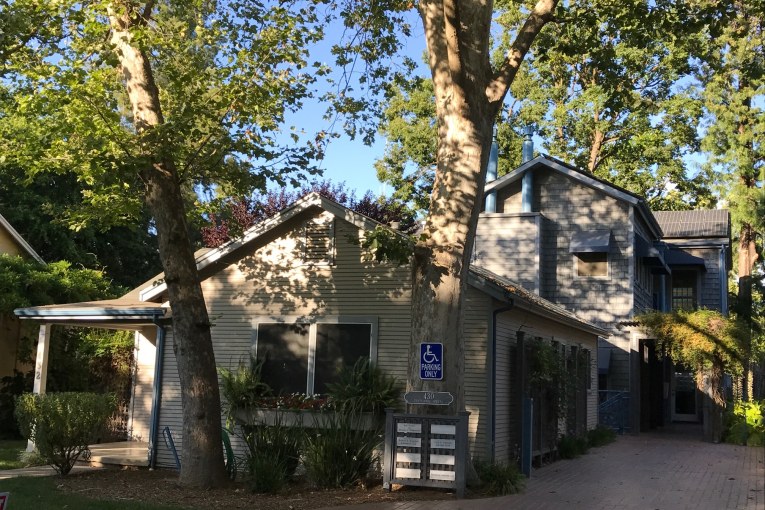
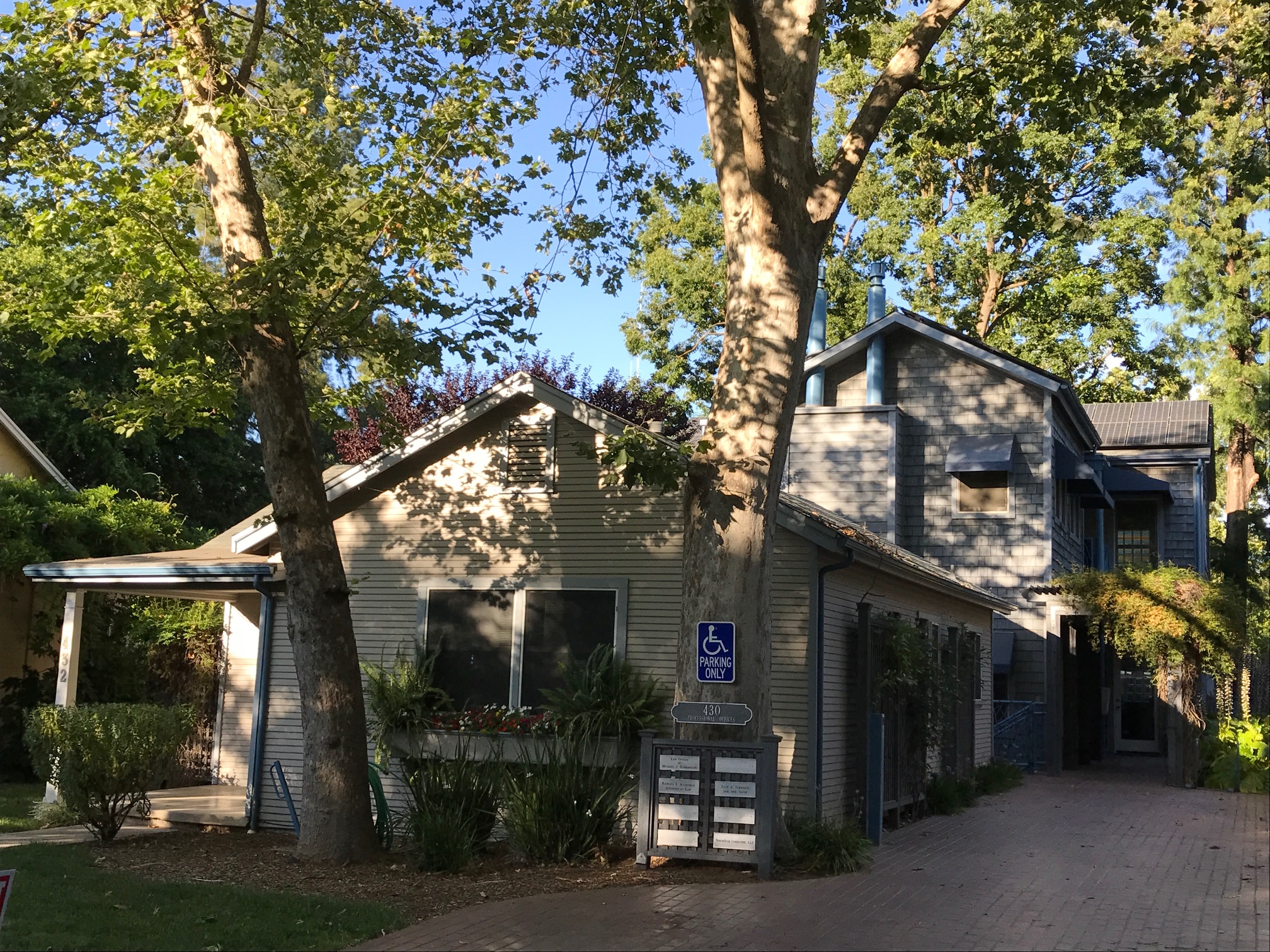
by Michael Bisch
““Parking craters”: The latest terminology used by some to abdicate responsibilities associated with development.” – Ron (anonymous Vanguard poster)
The negative impact of curb-cuts, driveways and inefficient private, onsite parking lots, i.e. “parking craters, on the pedestrian experience, urban retail shopping, social interaction, safety and downtown vibrancy has been well understood for decades…even in Davis. That is why our policy documents such as the Core Area Specific Plan, Design Guidelines and zoning ordinances have discouraged, and in some areas of downtown prohibited, new development of “parking craters” since the 1990s. The Core Area Specific Plan update currently underway should make for a very interesting exercise given the derision these well-understood urban planning principles were met with by some Vanguard posters yesterday, such as:
“A certain starry-eyed segment of utopian greenies become the worker bees for a certain segment of greedevelopers that wish to push through buildings with inadequate parking.”
As planning commissioner Rutherford recently stated, “the writing is on the wall”. These “starry-eyed greenie” urban planning principles will be advanced, not reversed in the Core Area Specific Plan update. I’m taking bets right now that parking minimums, a dinosaur of the past, will be replaced by parking maximums (which de facto brings parking in-lieu fees down to $0.00). We are not paying urban planning consultants hundreds of thousands of dollars to revert back to ’50, ‘60s and ‘70s-style urban planning.
To help Vanguard readers visually understand the difference between retro-projects (parking crater projects) and “starry-eyed greenie” projects, I offer these contrasting photos:
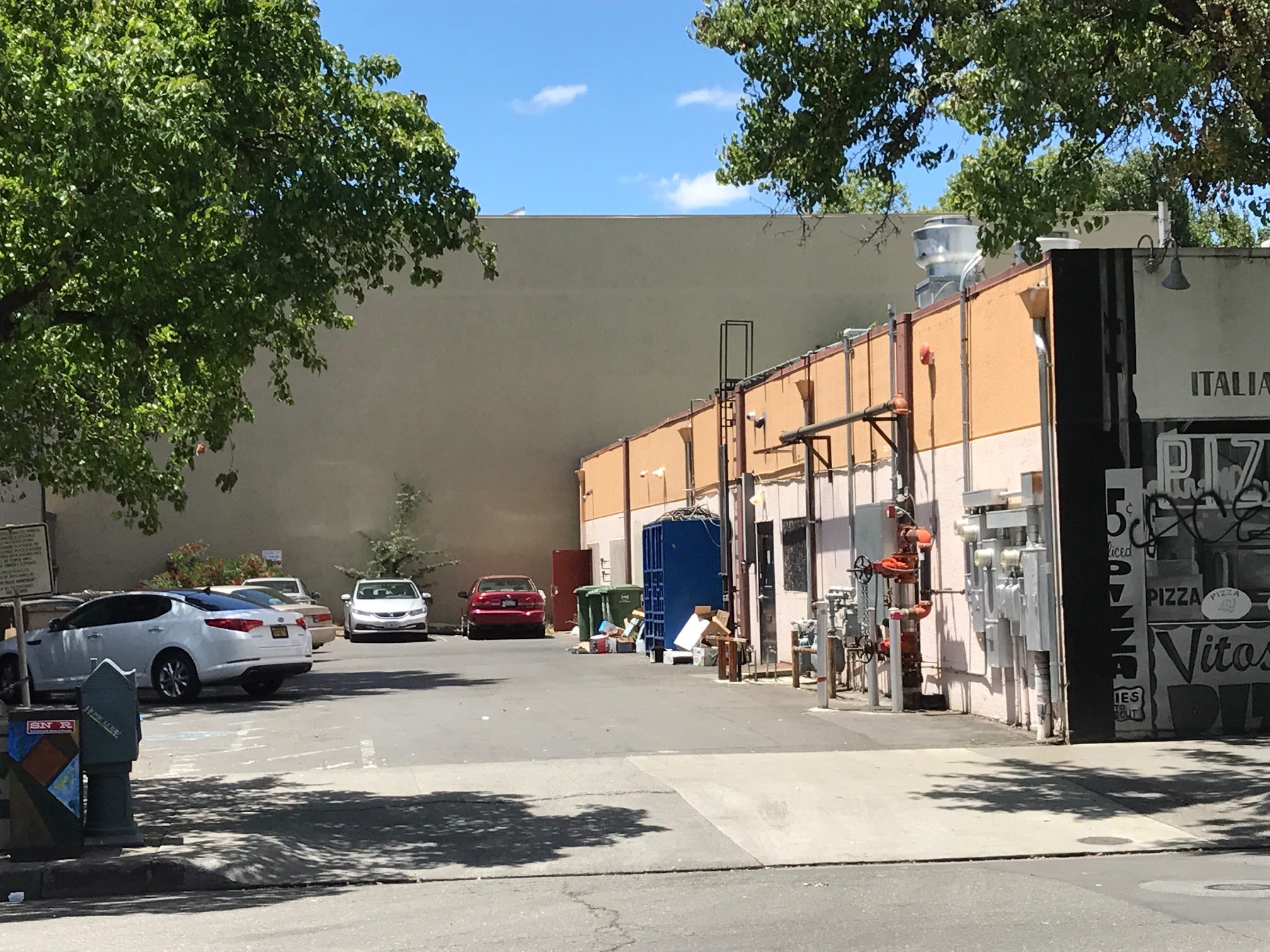
Caption: Uncle Vito’s Building (parking crater project)
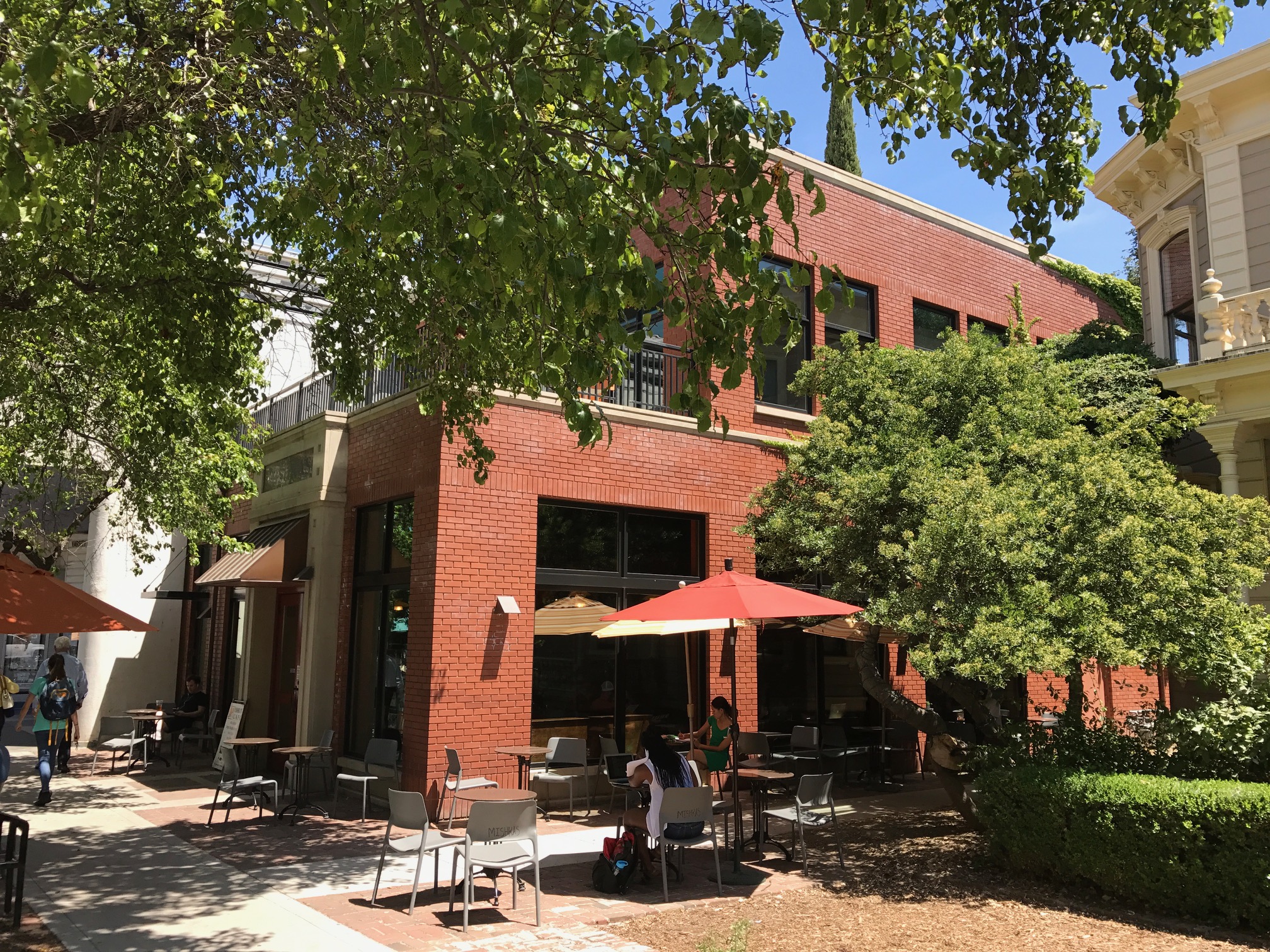
Caption: Mishka’s (starry-eyed greenie)
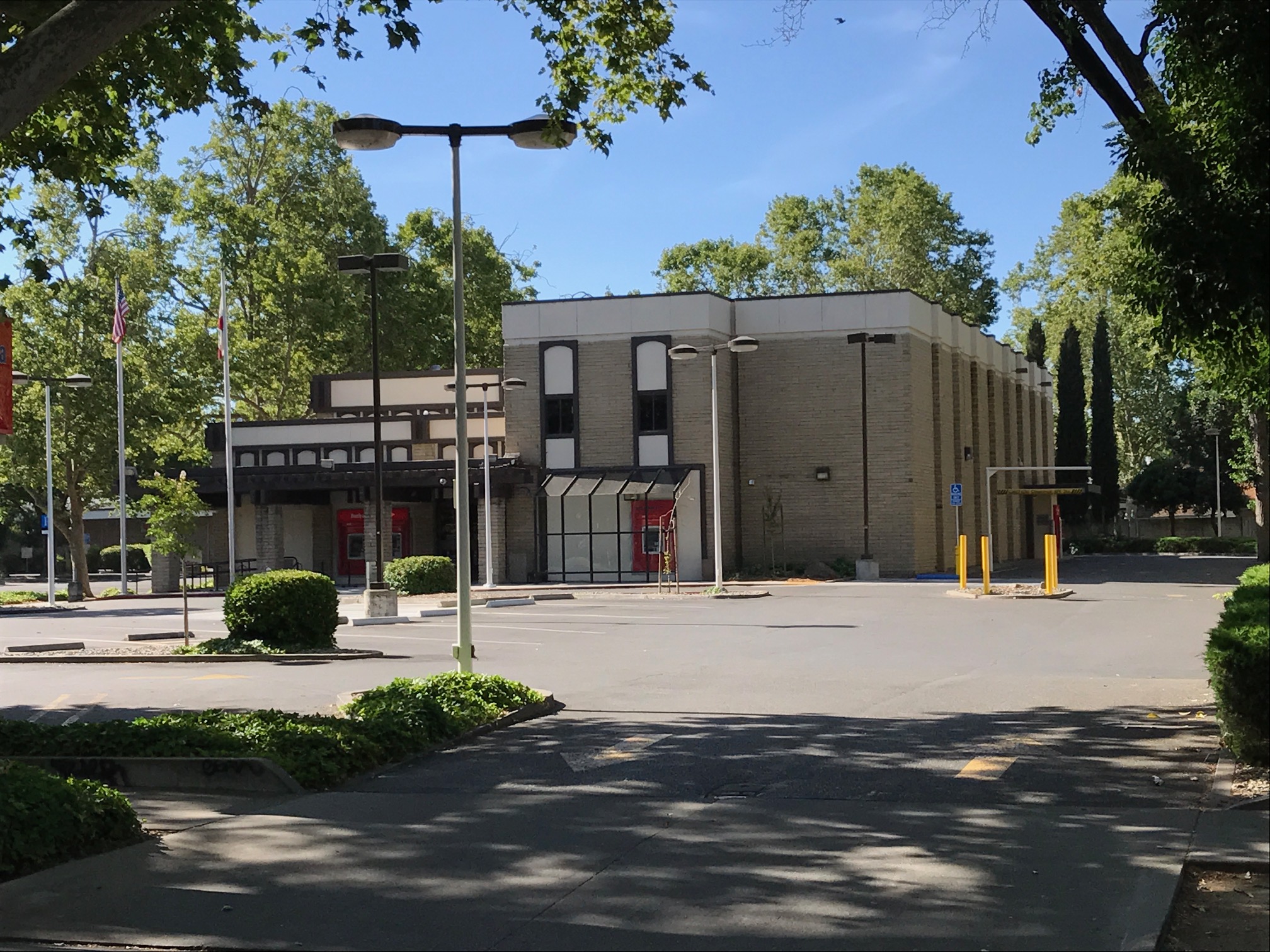
Caption: Bank of America Building (parking crater project)

Caption: Chen Building (starry-eyed greenie)
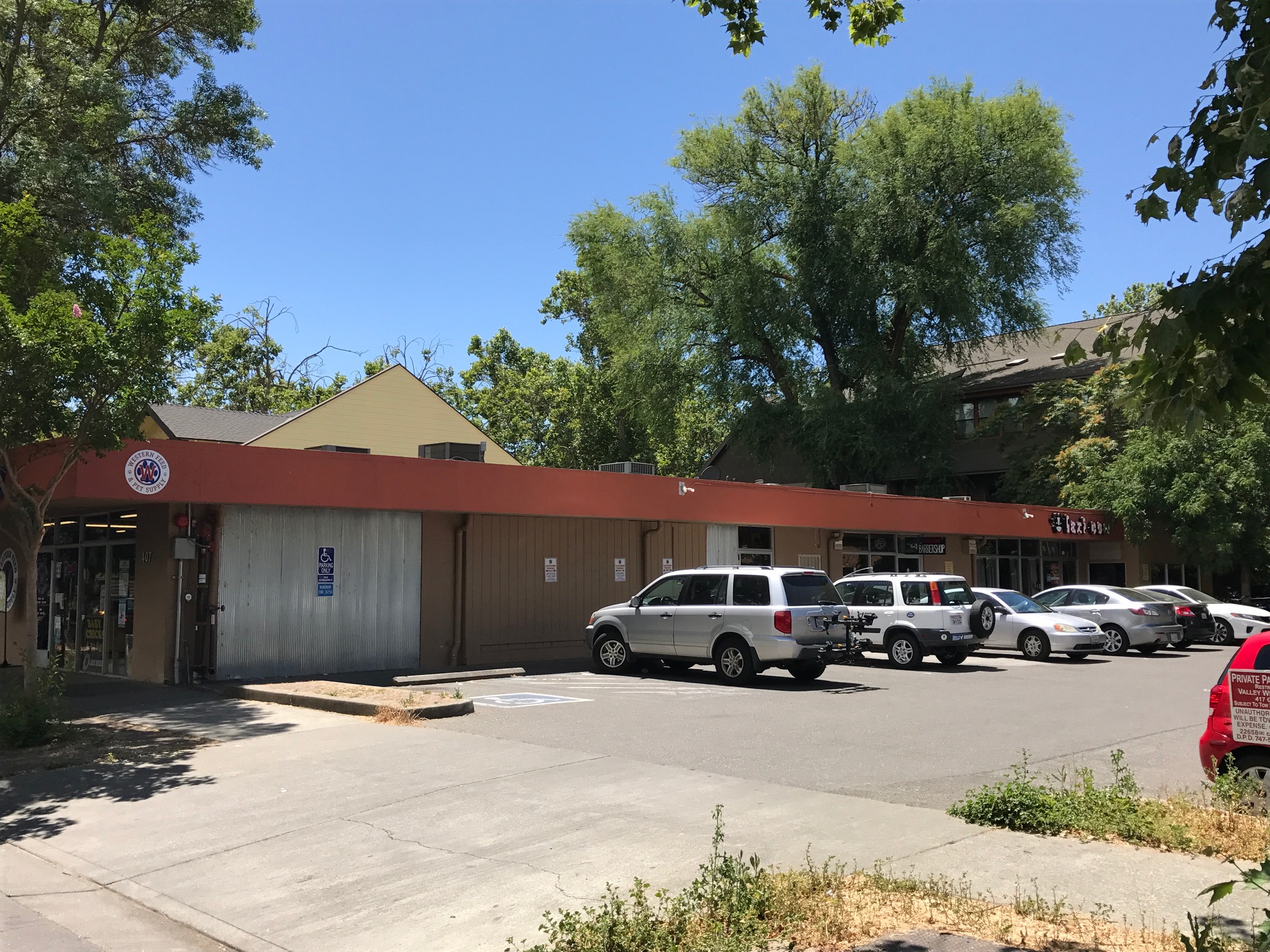
Caption: Pet Supply Building (parking crater project)
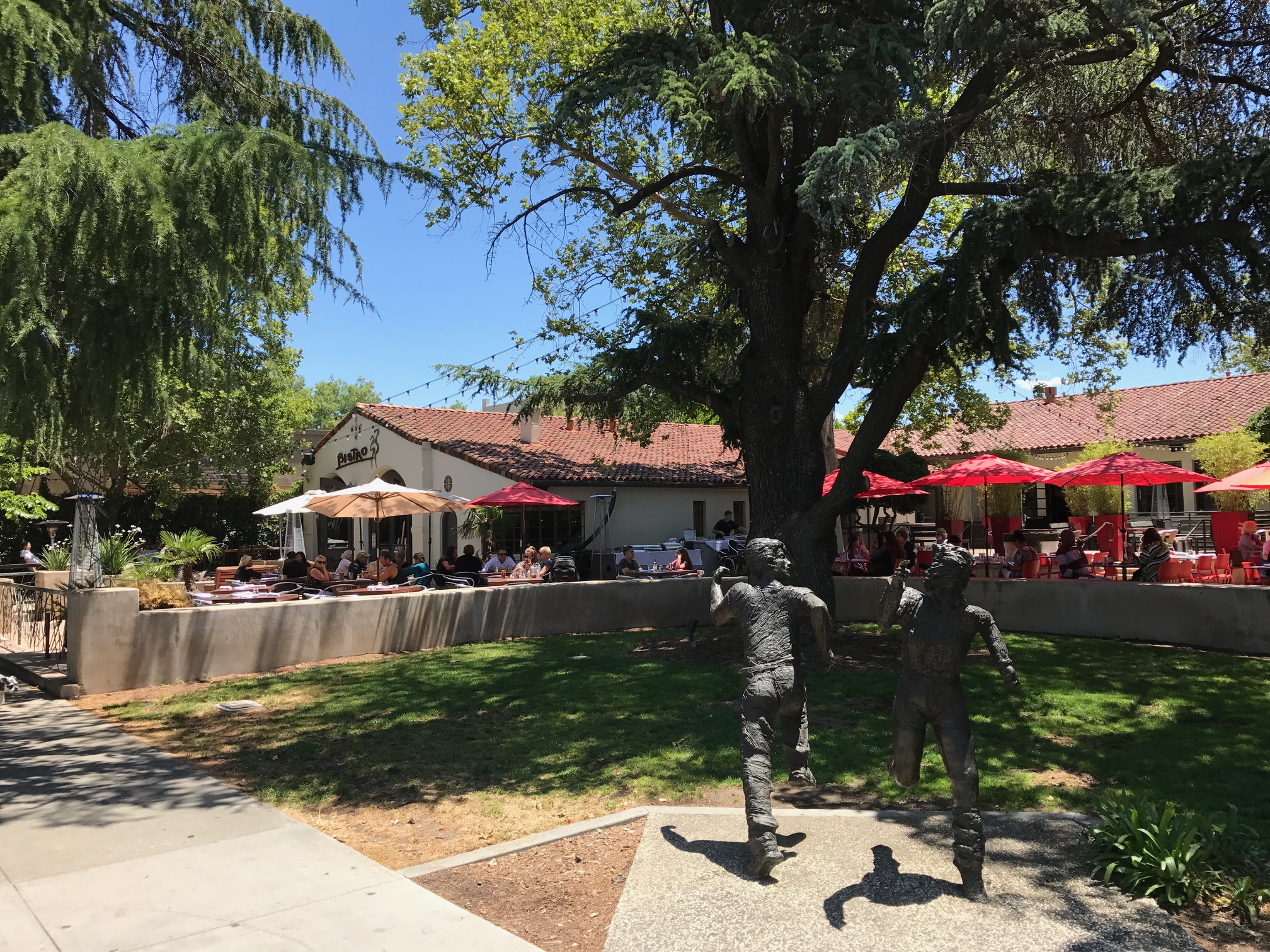
Caption: Bistro 33 Building (starry-eyed greenie)
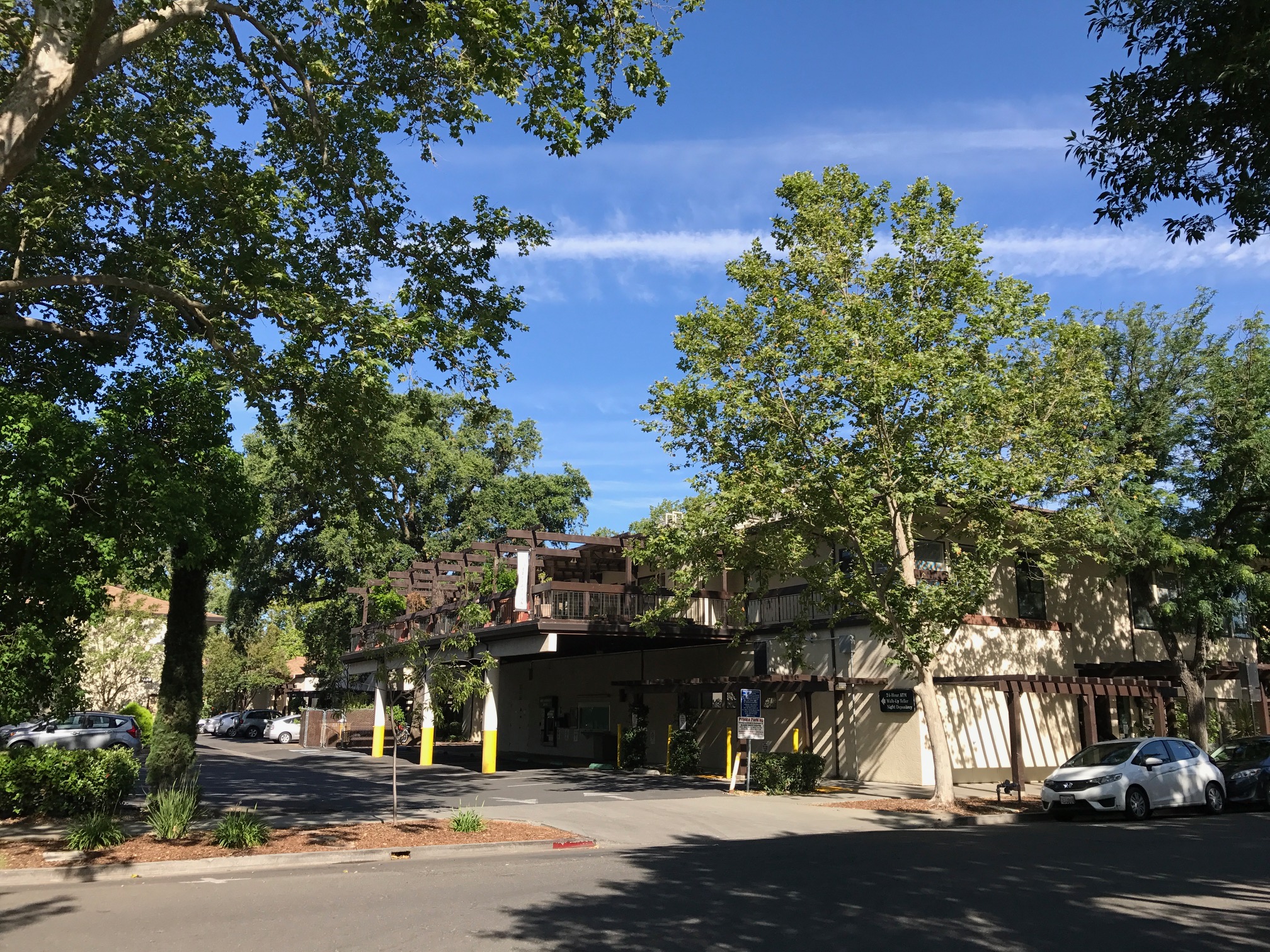
Caption: First Northern Bank Building (parking crater project)

Caption: Brinley Building (starry-eyed greenie)

Caption: AT&T Building (parking crater project)

Caption: Varsity Theater (starry-eyed greenie)
I leave it to the readers to weigh in on their preference. Should we encourage parking craters projects or starry-eyed greenie projects?
-Michael Bisch is the owner of Davis Commercial Properties, a provider of commercial property management, leasing and brokerage services. He has served as a volunteer in a number of downtown-related community service organizations such as Davis Arts Alliance, JumpStart Davis, Pathways to Employment, Radiate Art and Davis Downtown.

Ah – I think we finally have an acknowledgement of the “honest goal”, of some. Turns out it had nothing to do with “parking craters”, “new urbanism”, “1950’s thinking”, etc. (Why did I know that, already?)
Finally? “Honest goal”? It appears Ron is blissfully unaware that there is nothing new about this “honest goal”.
“In 1998, the Davis City Council adopted a new parking in-lieu fee policy that allowed downtown developers to seek reductions and waivers for parking in-lieu fees by incorporating ground floor retail and upper level housing among other urban design standards. The change in policy was meant to relieve developers and the downtown of an additional requirement that was considered onerous and could potentially discourage expansion of business in the Core. Furthermore, it was realized that the fees collected over the previous 20 years were minimal and inadequate to provide significant funding for a new parking structure, an oft-cited goal. Per Resolution No. 8343, the policy established the tiered system depicted in Table 1. ”
Numerous terrific projects, both large and small, have been enabled by means of this 1998 policy. In fact, Harrington informed me a week ago that his project, a starry-eyed greenie project, benefited from this policy.
Michael: We’re talking about the proposed changes to the “in-lieu of” program now, not what was done in 1998. (Regardless, your own quote notes that the fees have been inadequate for 20 years, now.)
I understand that the city is now considering raising these fees, to be more in-line with other cities. If you’re opposing that, I’d suggest that you just come right out and say it. (Compared to someone like Mark West, you tend to write in a cryptic manner.)
By the way, who are the “starry-eyed utopian greenies” that you’re referring to, in the title of the article? (Ironically, it’s been suggested that you’re the one using a “green argument” to avoid responsibilities associated with redevelopment.) Are you the “starry-eyed utopian greenie”, or is that your target audience?
Ron – I think Michael’s point is that there is already a zero in-lieu option on the books.
David: O.K. – thanks. But again, I understand that the program will be re-examined, and that there’s an option to eliminate reductions and waivers, and raise the fees. If that’s correct (and Michael is opposed to that), I’d suggest he come right out and say it. (In contrast, I have no problems following Mark West’s arguments.)
I’d also like to see a discussion regarding where parking lots/structures would be located, and whether or not (even) a revised fee would be sufficient to build parking. (Assuming that funds are directed toward that purpose.) (Ideally, parking lots would be covered with solar panels.)
I’d also like to see more analysis regarding what will likely occur if sufficient parking isn’t built somewhere near downtown, in terms of impacts on businesses and nearby residences, etc.
Nah – on second thought, let’s just refer to “starry-eyed utopian greenies”, and “Davis-crazy”, etc. (That’s much more useful.) Maybe some random photos posted repeatedly, as well.
By the way, adequate parking is even MORE of an issue as “upper-floor residences” are incorporated into downtown.
There’s a naïve belief among some that making it more difficult to park makes driving “disappear”. (Anyone who believes this is, in fact, a “starry-eyed utopian greenie”.)
If anyone believes that residents living downtown are simply going to walk or bike within a short radius of their homes, they’re mistaken. Most residents do, in fact, venture into the “outside world” via automobile.
Current ‘best practices’ for urban planning, as followed by the more progressive cities large and small, call for the removal of ‘parking minimums’ (minimum on-site parking required) from development projects and replacing them with ‘parking maximums’ (maximum on-site parking allowed). If there are no parking minimums, then there will be no fees ‘in-lieu’ of those minimums. If this change is implemented with the new General Plan and Core Area Specific Plans as has been suggested, then any current discussion of changes to the ‘in-lieu’ program will be moot as it will no longer exist.
“blissfully unaware”
Michael, you owe me a new keyboard for my computer. Thanks to you a mouthful of milk and Raisin Bran Crunch doused it and shorted it out.
I’ll blissfully send you the bill.
Matt: I apologize for being “blissfully unaware” of the details of the current program, and proposed changes (which haven’t even been discussed, in Michael’s articles). Seems to me that a well-written article would start with that type of an introduction.
Also, I’m not sure why Michael is simultaneously insulting the “utopian greenies” that he’s attempting to align with. Seems like an unusual strategy.
Man, some of those parking lots really need more trees. There should be an ordinance about what percentage of the parking area needs to be shaded by trees. Oh, wait, there is.
Trees purchased at the Redwood Barn, of course. Not that there’s anything wrong with that.
Is there an analysis of how many visitors the Mishka’s building has when compared with the previous use of the land – the Hunt Boyer Water Tower? If that number has increased, is there any analysis of the transportation mode they used to arrive there?
OK, I’ll admit it. I am a proud starry-eyed greenie. I am also working my way slowly, but deliberately towards an automobile free life style. I doubt I will get to 100% like the mayor, but am chipping away at it. Would like to invite as many as possible to join me. The “need” for parking spaces is 100% dependent on the choice to use one’s automobile.
And no, I am not talking about the extreme elderly or disabled, but that number is very small compared to the overall elective car users.
Tia: As long as you have a car, a parking spot is needed. (Even more so as you “slowly” and “deliberately” work toward an automobile-fee lifestyle.) Parked cars don’t cause a great deal of environmental damage.
Uber and Lyft do not eliminate driving. (In fact, such services probably create more driving, since the vehicle has to travel to pick up passengers.)
Perhaps more importantly (in terms of planning), I suspect that you’re in the minority regarding your goal, and will remain that way. (I guess a few people might be satisfied with never traveling outside a short radius near the homes. But, it seems unlikely that this will become the “norm”.)
Oh – and let’s not forget visitors to the new “upper-floor residents” that will live downtown, in the future. (Are they all going to arrive by train, Uber, and Lyft?)
How many of these new “downtown residents” will, in fact, be older (and perhaps can no longer travel via bicycle, etc.)?
People are still focused on designing around the use of a car. A couple of months ago, I bought my 90-year old father an electric scooter, mainly so he could attend baseball games, attend Picnic Day and Scottish/ music festivals, etc. with greater ease. Much to my surprise he is using it to travel from his home in North Davis to DeVere’s in downtown Davis once a week to meet up with other emeriti for “office hours.” It is easier than driving, managing the chaotic traffic of the downtown and then trying to find parking close to the restaurant. He can swing by the bookstore and run errands before heading home, without being limited by moving or staying close to where his car is parked.
Sharla: Yes, at a certain point in later life, many ultimately give up driving. (Hopefully, before they get in a serious accident.)
Until that point is reached, it’s not likely that you’ll see a massive change regarding car ownership, particularly in valley towns such as Davis. (And, elderly folks often rely upon family members, who are still driving.)
Again, lack of parking does not translate directly into lack of driving. (Assuming that’s the goal.) It does, however, allow developers to shift impacts elsewhere.
By the way, where does he park the “electric scooter”, when visiting downtown? (Hopefully, not blocking the sidewalk.) Perhaps not an issue, unless/until there’s lots of scooters around.
He drives his scooter right into the restaurant. He could leave it outside, but the restaurant is very accomodating. This is not a street-worthy scooter. He rides on the sidewalk. It doesn’t go faster than I can walk at a brisk pace.
Sorry Ron… if someone no longer fit to drive is in a crash, it is almost never an “accident”. Know this from professional and personal experience.
I know of at least two examples where folk were injured, and/or died, and City staff was blamed for ‘inadequate’ street design. The CC were freaking idiots on both, and spent tens of thousands of dollars to ‘correct’ what they perceived as ‘design issues’. Not design issues, except for the mechanical problem of the “nut holding the steering wheel in place”.
Engineers cannot fully mitigate for severely decreased perceptional and/or cognitive deterioration… whether caused by the ravages of age-related conditions, or even those temporarily brought on by use of ‘substances’.
Yeah, nerve was hit…
Howard: Your “nerve” is often quite sensitive. O.K. – crash, collision, whatever. (For that matter, I would imagine that those traveling on electric scooters are vulnerable to “incidents” on the street, as a result of interactions with automobile traffic – which is moving at an entirely different rate of speed.)
Jesus, obtuseness is rampant today. The fact that one of the commenters can’t even figure out that my use today of the term “starry-eyed greenie” is a play off a comment from yesterday critical of commonly accepted smart urban planning concepts is quite telling. Then the comment insinuating that there’s some secret plan to reduce parking in-lieu fees to zero when that is and has been the case since ’98. Hello! How can you spring a secret plan on the community when that plan already has been established city policy for the previous 20 years with countless public examples of it?
I’m going to ignore all the uninformed comments for the rest of the day and focus on the score card. As of 12:30pm, I’m calling it:
In favor of starry-eyed greenie development: 3 (including myself)
In favor of parking crater projects: 2
In favor of improving crater projects with more trees: 1
Undecided: 2
Surprisingly close score given the photographic evidence. As I said, the downtown visioning, Core Area Specific Plan update and form-based codes implementation should all be quite entertaining.
Michael: Not sure about your “scorecard”. Regardless, we’re talking about proposed changes to the 1998 plan, due to expected changes in planning, downtown. Your own citation indicated that “in-lieu of fees” are insufficient. Also, we’re supposed to refer to a comment from yesterday, to understand your play on words? (Sorry, not interested.)
Have some straightforwardness and honesty, regarding what you’re objecting to. The manner in which you write is unnecessarily off-putting. Just say it – you don’t want to pay any “in-lieu of fees”, and aren’t particularly concerned regarding the impacts that this will continue to have, as downtown becomes more developed (including residences, above the first floor). And, you’re hoping to enlist “starry-eyed greenies” regarding your advocacy.
To paraphrase a famous political exchange, “I’ve known some starry-eyed greenies. Some are friends of mine. Sir, you are no starry-eyed greenie.”
Some people write in a manner that is inclusive of those who need to be spoonfed, and some write with an expectation that readers will engage their brain and therefore won’t need to be told obvious conclusions. It is a matter of choice and style.
Mark: For better or worse, you write with a “club and hammer” approach. No mistaking what you advocate for.
Yet you frequently manage to misunderstand my comments and misrepresent my positions anyway (perhaps because you depend on your preconceptions rather than what I’ve written).
Sometimes, even spoonfeeding fails.
As do you, regarding my comments.
Since Michael (and now you) are avoiding the question, how do you propose to pay for off-site parking (including the additional needs generated by having residences and more businesses without parking, downtown)?
Are you proposing something along the lines of what Matt is proposing? If so, who is taking up the parking spots, now? And, what will the impact of that proposal be? (Especially as more residences and businesses are added, downtown?)
The same way we have always done it before. Michael gave you the answer a few days back, but I guess you weren’t paying attention.
Mark: Got it now, despite the apparent efforts by your friend (Michael) to deflect attention away from the question.
The answer seems to be that you’re proposing to not build any more spaces at all, not pay an “in-lieu of” fee comparable to other cities, and would like to take advantage of existing parking spaces via a game similar to “musical chairs”.
All while increasing the demand, via redevelopment (including residences).
Again, what I do like about your writing is that (unlike Michael) you eventually “say it like it is”, even though your “green” implication is misleading, as is your statement regarding Davis being exclusively an entertainment zone (as if people don’t drive for that, either).
Again, good luck convincing existing businesses and adjacent neighborhoods, regarding the impact of your plan. (Those are the people you’ll have to convince.)
Oh – forgot to add: You also seem to be advocating for the elimination of existing parking spaces (otherwise now known as “parking craters”), while increasing demand via redevelopment.
Hey – what could possibly go wrong, with this plan?
We can make Downtown and up and out and around town very accessible to means other than private car. We can copy the many other places that it’s been done – perhaps even in suburban-campus-near rural hybrid towns like Davis, or we can make our rules, be in the vanguard, just like like 50 years ago with bike lanes. We certainly need to work extremely hard with the most informed councilpersons, the most talented staff, the highest street design standards and a generous volunteer citizenry to make that access great for parents with multiple kids and elders — it if works for them it works for everyone else.
2018 hypothetical city council candidate: “If Davis is not safely traversed by everyone between and 8 and 80, and does not provide housing for people in the entire range of need, it’s simply not a good place to live!!”
Since I think that the cruelly-delusional, patronizing and destructive “starry eyed greenie” had me in its sight, I’ll gladly accept the title and ask that Michael add a hash mark thus.
I love the photo-examples above, was not aware of the 1998 law as much as previous policy that created the bad examples above. Aside from the removal of Capitalism, nationalization and eminent domain-ism, what can be done to incentivize the owners of these lots, to, um make more on them then free parking will ever provide by replacing the direct access by public car? Oh, did I just answer my own question?
The only real threat to more than a few individuals and companies who make money from car loans, fuel sales, car sales and so on is that a getting-down-with-a-real-downtown-no-frown-child-happying-clown zone is if housing access, unlike the re-born streetscape, is not democratic.
It’s not just not craters but canyons that are the problem. I don’t see a real distinction except in the formal sense between street parking and city-owned shared parking.
Hi Todd,
It was Alan Miller that made the “cruelly delusional, patronizing and destructive starry eyed greenie slur” in yesterday’s thread, not I. Ron was making similar comments. In today’s piece, I am mocking both of them for not recognizing commonly accepted, contemporary urban design principals. It’s pretty funny that Ron doesn’t even recognize it.
Michael:
You’ve been asked a number of times about your position regarding funding for off-site parking – which you seem to advocate in principle (if not funding). You continue to avoid discussing funding and other practical questions (as do some other commenters, today).
I guess it’s more fun to make mocking statements, than address actual questions. Seems like you’re more interested in b.s.
Looking forward to more pointless photos tomorrow, I guess. (Along with some “oh-so-clever” remarks. Anything but funding, location of parking, etc.)
Yes, and my intention was to insult people personally and encourage development, or parking lots, or turkeys, or something . . .
Hi Michael Bisch – again, your photo comparison rocked – sorry for the misunderstanding but YES, my comments on comments about people who look at the stars, etc were not directed at you. BUT I am more concerned that you said “depend on” cars rather than transit or other alternatives. (By the way – and also not directed at you – I believe that the City and UC Davis is pursuing a plan to make Unitrans fare-free – this would be a perfect thing to fund with impact fees of some type if it got people to Downtown and back relatively conveniently at times it was needed.)
Oh, no! It’s time for more near-future speculative fiction headlines in the local papers: “Bar owners say carfree Downtown is better for business, because when groups of friends ride taxis, use hailing services, or take buses and bikes their former designated driver has at least one drink…”. More taxes pays for the buses. Not starry-eyed but green I admit. Also green as in “greenie”. OK! Of course this is not a business plan, just making a point about positive indirect effects.
Anyway, the reasoning for the “starry-eyed greeny” comment is proving more and more ridiculous as I support impact fees of some sort be they “in lieu, with a view” referring to the full storefront window you can see from across the motor vehicle channel of a street because there’s no motorized conveyance stored there in public space temporarily, or a second meaning where “with a view” refers to one’s bellybutton, which someone who walks is more likely to see. We definitely need a “plan for full build out” for which – much earlier today – I described in typical starry-eyed greenological terms as an “access study” for Downtown.
I’m going to give the pro ’50s, ’60s & 70s development team a bonus point for their sheer perseverance with their uninformed drivel:
In favor of starry-eyed greenie development: 3 (including myself)
In favor of parking crater projects: 3
In favor of improving crater projects with more trees: 1
Undecided: 2
Folks, this is not at all difficult. There are even pictures! Do you prefer the projects with the inefficient, onsite, private parking? Or do you prefer the projects that depend on efficient, off-site, shared parking. Which of these two types of projects lead to a more vibrant downtown in your view?
Personally, I’d prefer a coherent argument, regarding the reason that you apparently don’t want to pay sufficient “in lieu of” fees. (Actually, you haven’t clearly stated your position regarding that.)
As you stated above, “folks, this is not at all difficult”. (Unless one strives to make it that way.)
Michael, if, “you prefer the projects that depend on efficient, off-site, shared parking,” what is your plan to pay for said parking?
Colin, efficient, off-site shared parking in Davis does not require any significant capital investment. What it requires is effective parking enforcement, with up-to-date license plate recognition technology.
For example, the Old North Davis parking district contains 437 street parking spaces and 208 residences. Many of the 208 residences have their own on-site parking as well. For example, with modern technology you could assign 229 spaces (left after subtracting 208 from 437) to Downtown Davis workers for off-site, shared parking. None of those 229 spaces would require any capital investment. We already have the license plate recognition scanners and software needed to do the necessary enforcement. All it takes is the political will to formally and legally designate all, or part of our neighborhoods near the Central Core as “Resident and Downtown Employee Parking Only.” The City of Davis graphic below from the March 2014 Downtown Parking Management Plan puts those 229 spaces into perspective. Using a similar “Resident and Downtown Employee Parking Only” approach in the Old East Davis and the University Avenue neighborhoods would add several hundred more efficient, off-site shared parking spaces, and at the same time improve the quality of life for the residents of those neighborhoods.
Matt: I’m failing to see who is “taking up” the existing parking spaces that you’re referring to. Nor am I seeing how a “resident and downtown employee parking only” program would be funded.
I am also not seeing how eliminating spaces for those who are not “residents and employees” would improve the situation (including for customers, visitors, etc.).
Finally, I’m not seeing how the need for an increase in spaces (as a result of redevelopment, inclusion of housing downtown) would be addressed by your suggestion.
Actually, it adds NO new spaces. It simply ensures that some cannot park in existing spaces on public right-of-ways (including visitors of residents, and customers patronizing businesses). How many “spots” would a resident be entitled to? Would they have to pay for a permit?
If downtown locations are then subject to metered parking, I suspect that customers will avoid downtown, entirely. (Not sure where new residents and their visitors will park, as new “2nd-floor” residences are added to the downtown area.)
One other point, regarding Matt’s proposal:
It (formally/legally) “shifts” the burden of providing parking for employees to surrounding neighborhoods. (I assume to ensure that downtown locations are “freed up” for metered parking.)
Nice years ago, but now as residents return home from work, restaurant employees (most of whom are too lazy to walk from the neighborhoods anyway) are just going to work.
And how does this solve future parking needs from a mass increase in residents downtown? I’m for increasing residents downtown — what I don’t see is a plan for funding where their cars are going.
Alan, as it is currently built out, Davis has an abundance of automobile-friendly housing available for those people who feel a need to own and garage a car. What we do not have is an abundance of housing that is pedestrian-centric in a town where the distance from Mishka’s Coffee house to the Memorial Union Coffee House is half a mile. By comparison, the walk from the Tercero Dining Commons to the Memorial Union Coffee House is 20% greater, and the the walk from Alder Hall Dormitory in the Segundo Dorm Complex is 40% greater, and the walk from the Colleges at LaRue Apartments to the Memorial Union Coffee House is 80% greater, and the walk from the Tercero Dining Commons to the Hub at West Village is 180% greater.
Bottom-line, mixed-use redevelopment of the Downtown Core should be starry-eyed greenie, and if it is, then the plan for funding where the residents’ cars are going will be easy, because there won’t be any residents’ cars.
Um . . . parking lots? Did I win the rainbow?
If you are the customer of a business downtown with on-site parking, you will be tempted to drive and park in that on-site lot. When your transaction is complete, you will get back in the car and drive somewhere else. If you have business let us say, at two other locations downtown each with on-site parking, you may end up driving to and parking at each subsequent location, each time increasing the number of cars on the street and utilizing in total three parking spaces for your one trip. Now if there were no on-site parking sites available, you would instead drive to one location, park, and perform your business on foot, walking from place to place while only utilizing a single parking spot (If you use Lyft or some other car sharing option, you might accomplish your business without using a single parking spot). On-street parking is the solution for those who need to park closer (for whatever reason), and the way to ensure that a street parking spot is available is with meters, setting the cost at a level where on average a few spots per block are always available. When those obsolete on-site private parking lots are redeveloped into well designed mixed-use multi-story buildings, then there will be greater business activity in the region and new customers living just above. The result being, a more economically vibrant downtown, with greater resources going towards addressing the needs of people and fewer being utilized for parking their cars.
This isn’t some pie-in-the-sky dream but is something that has been replicated in cities throughout the State and Country. All we need to do is let go of the 1950’s thinking on parking and development.
“Now if there were no on-site parking sites available, you would instead drive to one location”
True, though that single parking space would be in Woodland or Dixon which have actual stores. Not sure why people think that making it even more inconvenient will attract people.
Jim: I was right the first time I made this comment – you do have a sense of humor.
Downtown Davis abdicated its role as a shopping destination years (decades) ago, which begs the question why we continue with the ‘free parking for everyone’ folly now. Downtown Davis is an entertainment zone, and our planning going forward to should recognize that and respond accordingly.
Current retail members of Davis Downtown as of January 2017:
A Better Place to Bead
Absolute Cellular
Advanced Energy Products
Animal Supply Logistics
Armadillo Music
Art 26
AT&T Wireless
Avid Reader Active
B&L Bike Shop
Bath & Body Works
Bizarro World & 4 Star Movies
Boheme Used Clothing and Gifts
Bubble Belly
Candy House of Davis
Casa Verde Designs
Clickaway Mobile
Couleurs Vives Art Gallery and Studio
Crème de la Crème
Crucial Vibes Unlimited
Davis Ace Hardware
Davis Card and Games
Davis Food Co-op
Davis Gold & Silver Exchange
Davis Sport Shop
Davis Textbooks
Davis Wheelworks
Fast & Easy Mart
Fleet Feet Sports
Found: Antique Jewelry and Objects of Interest
Freewheeler Bicycle
Generations Family Footwear
Hastings Back Porch
Haute Again Consignment
Hibbert Lumber
Himalaya Gift Shop
Ho Ho Market
IRC Tire
Jeeba Creative Jewelry
Ken’s Bike Ski Board
Kim’s Mart
Kwan’s Framing
Logos Used Books
Luro Jewlers
Miyamo Boutique
Mobile Connections
Mother & Baby Source
Newsbeat
Optical Phases
Philanthropy
Pinkadot
Putah Creek Winery
Radiate Art
Radio Shack
Riki
Rire Boutique
Rivers to Reef
Shop Cuffs
Shu Shu’s Clothing and Accessories
Sleep Center
Soccer & Lifestyles
Sole Desire
SPCA Thrift Store
T-Mobile Store
Tarad Thai Market
Teach Your Children
The Artery
The Avid Reader
The Davis Beer Shoppe
The Gap
The Illusions
The Paint Chip
The Vault
The Wardrobe
Third Street Jeweler
Tibet Nepal
UC Davis Store Downtown
Valley Wine Company
Volleys Tennis Shop
Western Feed & Pet Supply
Mark: Thanks for “clearing that up”. After all, it’s not like people drive to entertainment destinations, restaurants, ACE Hardware, etc.
In any case, Don is probably correct (above, and below). Your fight (apparently shared by your friend Michael) to abdicate parking responsibilities generated by new businesses and residences downtown is probably going to be with existing business owners, who would be impacted by such plans when a redevelopment project arises. (That group, and adjacent neighborhoods.)
Good luck, with that. (Probably easier and better for all parties concerned – including interests related to redevelopments, to just pay the fee in the first place.) However, I suspect that you’d rather continue to advocate for “musical chairs/parking spaces”, instead. (With an insufficient supply of spaces.)
Yes, Don…and how well are we doing on per capita sales tax revenues compared to say Dixon or Woodland (or any other town you choose in northern California)?
I was just replying to your relentless, ongoing denigration of the retail stores of downtown Davis. There are more than 80 of them by my count. So your statement that “Downtown Davis abdicated its role as a shopping destination years (decades) ago” is wrong. Downtown Davis is a stronger downtown shopping destination than any other city in the region. Dixon and Woodland do not have strong downtown retail by comparison, nor does Vacaville or Fairfield.
Higher per capita sales tax revenues will come from retail developed outside of the downtown. That is what those cities did. They also mostly chose to destroy their downtowns in the process. That isn’t necessary. In Davis, the properties for that additional revenue are in auto sales.
You know all this. So why you repeatedly choose to dismiss the downtown retailers, I don’t know. You’ve been doing it for years on the Vanguard.
When have I denigrated any downtown store? Please show me the words that I have used in my “relentless, ongoing denigration of the retail stores of downtown Davis.” Exactly what store have I denigrated? My comments are directed at the Davis community and our past decisions, not the stores or their owners. You need to take a few twists out of your knickers (and stop misrepresenting my comments).
Our per capita sales tax revenues are a result of our communities decisions to not support retail in town. Read our zoning regulations and the Municipal Code, and peruse the General Plan, if you want to understand.
I did not say you had denigrated any particular store.
Mark West:
Which just happens to have 80+ retailers. But I guess they lack in value or are of little importance.
I am very familiar with our municipal code and our General Plan.
Radio Shack? That’s so early 2017.
And where is the Davis Shoe Shop?
So according to Don’s post, Vito’s is not a member?
“Downtown Davis is an entertainment zone, and our planning going forward to should recognize that and respond accordingly.”
Completely agree. I have a family of five and the only money we spend downtown goes to food/coffee/entertainment with a very small amount at the farmers market. Trader Joes gets a chunk as does UCD itself. This will not change with the dispensaries.
BTW I’m a Peet’s guy while the wife is all about Mishkas.
Don’s list is for the retail businesses. Radio Shack, Philanthropy, and Jeeba Creative Jewelry have all closed. Davis Downtown has its current listing of 75 retailers here. Uncle Vitos is a restaurant, and is listed in the listing of 97 dining members here. They have 657 members total listed here, with 9 Entertainment businesses, 283 Services businesses, and 165 Professional businesses.
Re: Vito’s, several years ago it was raining and I was hurrying to my car, in the dark. Vito’s parking lot had uneven pavement and I tripped and fell and hit my head. Lucky for them, I was in the midst of moving away from Davis. Their parking lot had no lights and it was very unsafe at night.
I recently saw a presentation by a woman from a Sonoma County consulting firm that specialized in helping clients reduce parking requirements for their developments, by evoking things like “transit oriented development” (TOD). She was proud to have helped densify downtown Petaluma, partly using TOD via the new SMART train. I pointed out to her the extremely low capacity of SMART as currently designed, but she was not aware, nor did they take numbers into account, only policy with TOD. I then p0inted out how Washing Blvd. is now gridlocked from downtown to 101 since the new dense buildings added so many new residents. Forgetting her role as a consultant for a moment, she had an emotional reaction to the new traffic and exclaimed, “Yeah, isn’t it terrible?”.
The point is that the goals expounded of a dense residential downtown are a good goal. But there’s no plan, only cries to reduce car use and reduce fees. You have to have plan to fund transportation alternatives, and a plan to put resident’s cars somewhere, or force them economically via parking fees to have no cars. You can’t simply wish cars away, and have a “starry eyed greenie” ideal that not having parking spaces leads to no cars. That feeds into developers who want to use greenie ideals to reduce fees but have no plan on how those impacts are mitigated.
To be clear, I am for densifying downtown, in building mixed-use buildings downtown, and greatly increasing residents in the central core. But FIRST, Davis must have to have a realistic plan for how people get around at full build-out, a plan to get there, a place for those who have cars, and a structure in-place for how the mitigation is funded.
So put me down for favoring this sort of downtown development, but not as a starrie-eyed greenie.
Somehow I foresee a coming conflict between downtown retailers and someone who wants to do a major redevelopment of one or more of the buildings there….
Don, if the redevelopment happens in a logical step-wise sequence there really shouldn’t be any conflict between the existing downtown retailers and the property owners.
For example, if the first parcel to be redeveloped is the existing Davis Ace Housewares building parcel, producing a new four-story (or possibly even five-story) building with 3-4 stories of residential over a single story of commercial space, then the retailers who occupy the second phase to be redeveloped, for example the two parcels on the south side of Second Street between F Street and G Street (Sleep Center and Generations Family Footwear in the first parcel and Mother and Baby Source, University Wireless, Optical Phases, Metro PCS, Aggies Barber Shop and Froggy’s Grill in the second parcel) could move into the new store fronts created along G Street in the new redeveloped Davis Ace Housewares parcel.
Then the third phase could be the Browman Quessenberry and Brinley Buildings on the north side of Second Street between E Street and F Street, with the retailers in those buildings relocating to either the phase one or phase two newly renovated buildings. Or alternatively the south side of Second Street between E Street and F Street could be done next.
If you do the redevelopment that way, the businesses never find themselves literally without a place to do business, and the new location would be up to date new construction rather than refitted old construction.
Is Jennifer Anderson thinking of redeveloping her property?
I agree that the downtown redevelopment goals have to be achievable. That was the thrust of my comments at the Davis Futures forum a couple weeks back when I participated on the panel. While the current CASP has some wonderful aspirations, we have numerous policies that prevent us from making meaningful progress toward those aspirations. As Robb pointed out last Tuesday, the CASP update currently underway is meant to address those shortcomings. And the way one goes about that is to form consensus on what the community wishes to achieve and then create policies that get us there, not the other way around as a number of folk have argued here. There is rampant confusion in some of the comments these past few days between means and ends.
-Michael
A mean employee of UCD’s downtown bookstore called the cops on my hairdresser and had the poor guy’s car towed away immediately after they designated some spaces behind my hairdresser as exclusively for their bookstore. He wasn’t even aware of the change. They used to be jerks.